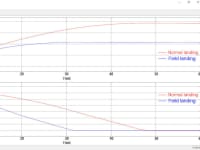INTRODUCTION:
A dream it was for a man to fly before the invention of aircraft. In the esteemed domain of aircraft, landing is the most challenging part, where most of the accidents have happened.
PROBLEM DEFINITION - After some research, we found that a considerable percentage of landing accidents were due to overrun.
SOLUTION - This entry focuses on eliminating the risk of overrun by reducing the aircraft’s landing distance using field theory. This can also be a solution to the planes that land on an aircraft carrier which use the conventional ‘tail hook’ system.
WORKING:
As shown in the illustration-1, the grey cylinder represents the aircraft moving towards the plane of paper; the green mat is assumed to be the runway and the red bars under the runway are the superconductors. When current passes through the super conductors, a field is produced perpendicular to the aircraft. This field interacts with the body, whose fuselage is duralumin. By Fleming’s right hand rule, a current flows downwards, tangential to the body. On the contrary, by Fleming’s left hand rule, a force (Fe) is created opposite to the direction of the aircraft’s movement. This force acts along the drag, providing additional deceleration which is proportional to the magnitude of field produced and the landing distance varies inversely with it.
To translate this hypothesis to reality, superconductors are placed beneath the runway. A cooling system maintains the operating temperature of the superconductors and controls the current flow through it. Nevertheless, recently physicists have kept a piece of ceramic in a superconductor, disproving that materials have to be cooled to at least -140 degrees to achieve superconductivity. Thus the difficulty in it’s implementation decreases.
The MATLAB simulated results shown in the illustration-2 are obtained with the assumption that the landing distance will be reduced to half of its actual value for a given aircraft. We took the Airbus A380 for study. It is clear that an A380 that usually takes 2 kms to complete its landing, takes only around one km with this technique.
The velocity-time curve shown is linear and there are no ups and downs, which tells us that there won’t be any jerk or jolt with this technique. Also the g-forces associated with the passengers inside the aircraft are well within the human bearable limit of 1.16 , as shown.
In aircraft carrier ships, a high tensile wire is hooked to the plane’s tail during landing to decelerate it. We can see how difficult and risky it is even while hearing it. The proposal can aid this domain too. The idea proposed is unique and no such mechanism is found in the present.
BENEFITS:
1) Overrun accidents can be prevented.
2) As the aircraft is landed sooner, the air traffic control is improved.
3) The fuel consumed during loitering time can be saved.
4) The constructional length of aircraft carrier ships can be reduced.
All these benefits come with the aspects of normal landing and no disruption in the passenger.
Like this entry?
-
About the Entrant
- Name:Navaneeth Murali
- Type of entry:teamTeam members:Krishna Kumar R Navaneeth M Shachin Shibi R
- Software used for this entry:MATLAB - Simulink
- Patent status:none








